If you have ever read through the Old Testament (primarily Exodus, Leviticus, and Deuteronomy), you quickly see the heavy requirements for keeping festivals. These “appointed days or assemblies” commemorated specific occasions when God, in His supernatural power, intervened for His people. By celebrating these holy days regularly, the Hebrews were perpetually reminded of Yahweh’s power and greatness over their destiny.
But considering Christians are not bound by these Old Covenant requirements, why is understanding the importance of the biblical festivals so important?
- They were appointed by God and therefore have valuable lessons. Leviticus 23:2
- These festivals and regulations all point forward to Jesus Christ. Colossians 2:17
- Our understanding of the full meaning of Christ’s sacrificial death, burial, and resurrection can only be enhanced by growing in our knowledge of these festivals.
- In understanding, one gains deeper gratitude for the prophetic saving work of Jesus and the Christian holidays we observe.
- Festivals are mentioned throughout New Testament writings.
Grab your free copy of Understanding the Importance of Biblical Festivals for Christians and let’s get started!
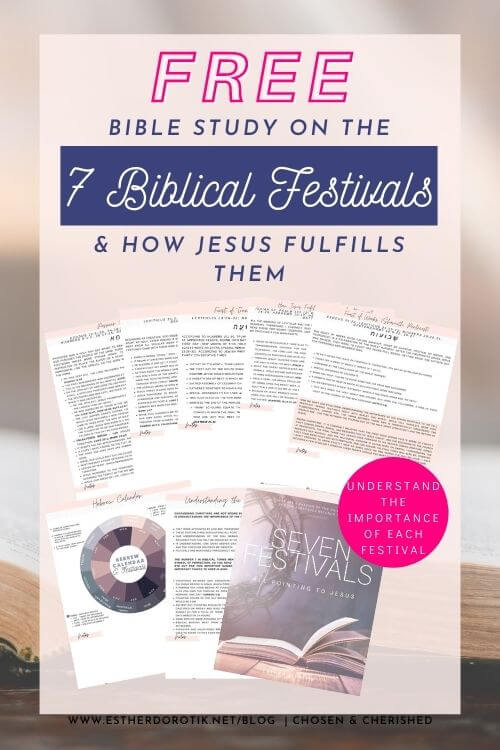
What are the 7 major festivals?
The number 7 in biblical terms means completeness and has been called the symbol of perfection. As you read through and study these festivals, keep an eye out for this important number. Before getting started, here are a few important things to keep in mind.
- Variations between our Gregorian calendar and the Jewish calendar. The Hebrew calendar begins in Nisan, which corresponds with our mid-March to mid-April.
- A Hebrew day (yom) begins at sundown and continues until the following sundown. This also follows the timeline of creation found in Genesis (“And it was evening and it was morning, one day.” Genesis 1:5).
- Counting hours of the day began at 6 am (first hour). So, for example, the third hour would be 9 am.
- Ancient day counting began on the day the sequence started. So, for example, Jesus was crucified on Friday and rose on Sunday. So they counted Friday (1), Saturday (2), and Sunday (3) for a total of three days. Current time counting would say it was two full days based on 24 hours.
- Some months were renamed after exile in Babylon (586–538 B.C.).
- Biblical months went from new moon to new moon and were established by two witnesses.
- Passover and Unleavened Bread are always celebrated together, and both names are used to refer to this 8-day period (Luke 22:1).
Okay, let’s jump into understanding the importance of these biblical feasts.
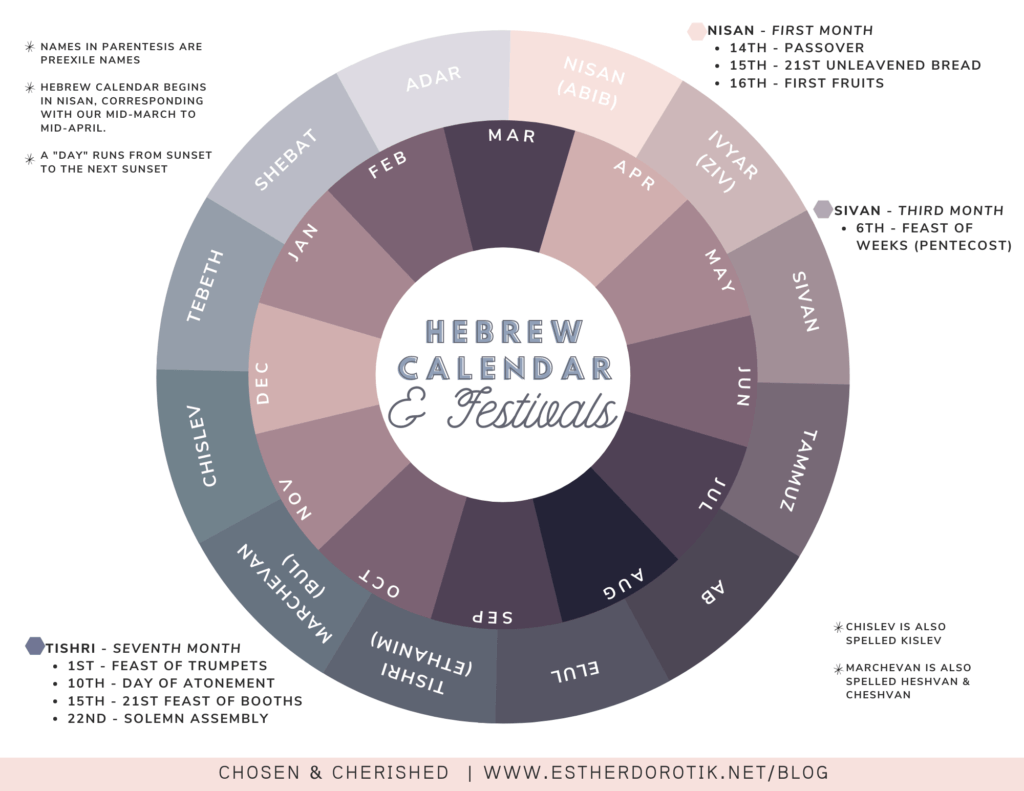
1 | Sabbath – שַׁבָּת
Beginning at creation, God modeled this perpetual day of rest. He blessed it and set it apart as holy, later making it one of the Ten Commandments. This is a complete day of rest from all secular work following six days of work. Many of the feasts and festivals came with their own sabbaths aside from this weekly observance. (Referenced Leviticus 23:3; Exodus 20:8-11, 23:12, 31:15; Deuteronomy 5:12-15)
- Sabbath means “cease,” “rest,” or “desist.”
- It began at creation when God modeled adherence after six days of work. Genesis 2:2
- He blessed it and set it apart as holy. Genesis 2:3
- A weekly day set apart day unto the Lord with no work. Leviticus 23:3
- Setting aside the weekly Sabbath is the Fourth Commandment. Exodus 20:8–10
- This was a sign of the Israelite redemption from slavery in Egypt. It is still by His mighty hand and outstretched arm that He leads us out of the land of slavery in sin and death through Jesus Christ. Deuteronomy 5:15
- The scrolls (Word of God) were read in the synagogue every Sabbath. Acts 13:27
- Jesus Christ is Lord over the sabbath. Matthew 12:8
- Jesus continued to model the celebration of the Sabbath by going to the temple synagogue and teaching. However, He did not adhere to the manmade Sabbath rules that burdened His people. Luke 4:16
- Sabbath was made for man to rest from work, rely on God’s provision, and remember Him. Mark 2:27
- While Paul suggests we are not bound by the Sabbath (Romans 14:5-6; Colossians 2:16-17), we should strive to achieve it for our own good. After all, it was modeled by God at creation, created to remember freedom from slavery, upheld by Jesus Christ, and celebrated by the first Believers. Hebrews 4:9–11
If you’d like more information on how Jesus fulfilled thise spring feasts during His first advent, this post on the detailed timeline of Holy Week might be helpful.
2 | Passover (Pesakh) – פִּסְחָא
Passover was a holy day set apart to remember the great Exodus from Egypt when God punished the people of the land. During this tenth and final plague, all Egyptian firstborn males were struck down. To escape this judgment, Israelites were instructed to place the blood of a spotless lamb over the doorpost (vertical and horizontal like the Cross), so the Lord would “pass over” the firstborn male within the home. (Referenced in Exodus 12:2–20, 34:18-21; Leviticus 23:5-8; Numbers 9:1-5, 28:17-25; Deuteronomy 16:1-8, 16-17)
- On this very day, the Lord delivered the people of Israel out of the land of slavery. Exodus 12:51
- The first anniversary was celebrated at Sinai. Numbers 9:1-5
- This is the beginning of all months. Exodus 12:2
- On the 10th day of Abib (now called Nisan, which corresponds with our mid-March to mid-April), a spotless Passover lamb was examined and chosen.
- The spotless lamb was kept, watched, and examined until the 14th day of Abib at twilight, when it was sacrificed.
- On the 10th day, Jesus triumphantly rode into Jerusalem as the crowd declared Him the chosen “King of Israel.”
- He was inspected by those in the temple, Pilate, and Herod, and no guilt was found in Him. Luke 19:47; John 18:38; Acts 13:27-28
- The Last Supper (Lord’s Supper, Lord’s Table, Communion) was the Passover meal in which Jesus declared a new covenant in His body and blood. He became the Sacrificial Lamb to “pass over” the sins of His people. Luke 22:14-20
- Like a lamb, Jesus was born in a stable and first visited by shepherds and was led to the slaughter to be our Passover Lamb (1 Corinthians 5:7, John 1:29, Rev 5:5-6). We now celebrate this day as Good Friday.
- Unleavened Bread – מַצָּה (Passover and Unleavened Bread are celebrated together. Luke 22:1; Mark 14:12)
- It starts the day after Passover, the 15th day of Abib. (Leviticus 23:6-8)
- It lasts 7 days, ending on the 21st. (Exodus 12:18)
- The first and last days are sabbath days of rest in which no occupational work was done.
- Israelites could only eat unleavened bread for 7 days.
- Must present a food offering to the Lord for 7 days.
- Leaven or yeast, which represented sin in the Bible, was purged from the houses and the territory.
- Jesus referred to the Pharisees and Sadducees as having leaven (Matthew 16:6) and cleansed the temple of the sin (John 2:13-16).
- Jesus, our Bread of Life, lived a perfect, sinless life (John 6:51; 1 Peter 2:22)
3 | Firstfruits (Yom Havikurim) – רֵאשִׁית
Yom Havikurim, Feast of Firstfruits, was celebrated on the third day of the Passover/Unleavened Bread celebration. In a show of thanksgiving, the priest would wave the sheaf (a bundle, likely barley) before the Lord. (Referenced in Leviticus 23:9-14)
- On the 16th day of Nisan (pre-exile Abib).
- Individuals could not partake in the harvest until this offering was made.
- Marked the beginning of barley harvest.
- Jesus’ resurrection on this day brought fulfillment to this festival. He became the Firstfruit from the dead that in everything He might be preeminent. (1 Corinthians 15:20 & 23; Colossians 1:18; Revelation 1:5)
- This marks the beginning of a harvest for which Jesus will return.
- This is Resurrection Sunday.
4 | Feast of Weeks (Shavuoth, Pentecost) – שָׁבוּעוֹת
The Feast of Weeks (also called Shavuot, Feast of Harvest, Festival of Weeks, and Pentecost) is a celebration of the wheat harvest. After the Firstfruits (when Jesus was raised), they were to count off seven full weeks, setting aside the fiftieth day for offerings and celebrations. (Referenced in Exodus 34:22; Leviticus 23:15-21; Numbers 28:26-31; Deuteronomy 16:9-12, 16-17)
- 50 days after the Feast of Firstfruits; therefore, 6th day of Sivan (our May/June)
- Count off a week of weeks (7 weeks of 7 days).
- Happened at the conclusion of the wheat harvest.
- Special offerings to celebrate.
- When you reap, you’re to leave some for the poor and sojourner.
- A sabbath day of rest in which no occupational work was done.
- Called Pentecost in New Testament, which is the Greek word for “fiftieth.”
- This was when the Holy Spirit was poured out upon the followers, a kind of first fruit of the church of the New Covenant (Acts 2:1-4).
If you’d like more information on how Jesus fulfilled thise spring feasts during His first advent, this post on the detailed timeline of Holy Week might be helpful.
Now we shift our eyes from understanding the importance of the spring festivals to the fall festivals. Spring festivals dealt with barley and wheat, while fall harvests were figs, pomegranates, grapes, etc. The timing between these two is prophetically considered the church age – the time between the pouring out of the Holy Spirit (Pentecost) and the return of Jesus.
Among Christians, it is commonly believed that the first four spring feasts speak of Christ’s first coming (death, burial, and resurrection of Jesus Christ, and the beginning of the church at Pentecost). The final three fall feasts look forward to His second coming (Rapture, Israel receives her Messiah, and the millennial kingdom is established on earth). **Considering the first four were fulfilled with precision, one can assume the final three will also be; however, I don’t presume to know exactly how or when since no one knows the day or hour. I have included a few scholarly views on these feasts should you want to investigate on your own.
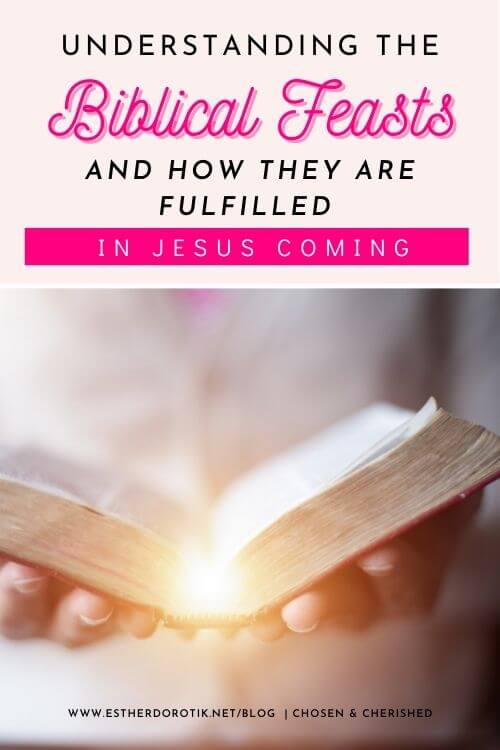
5 | Feast of Trumpets (Rosh Hashanah) – זִכְר֥וֹן תְּרוּעָ֥ה
According to Numbers 10:1-10, trumpets were blown on the first day of every month, at appointed feasts, going into battle, and summoning the congregation. But, on the first day (new moon) of this holiest month (seventh month, Tishri), these trumpet blasts were an extra special reminder of the approaching Day of Atonement (Leviticus 23:26–32). According to Jewish writers and historians, these trumpets were sounded thirty consecutive times. Referenced in (Leviticus 23:23–25; Numbers 29:1–6)
- 1st day of 7th month, Tishri (pre-exile Ethanim, which was also the sabbatical month).
- The first day of the month began on a new moon, which required two eyewitnesses to confirm, which could occur over a two-day time period.
- A sabbath day of rest in which no occupational work was done.
- Sacred assembly of celebration announced by the blowing of trumpets.
- Gathered together to hear a public reading of the Law.
- Special offerings to the Lord. Numbers 29:1–6
- This took place on the new moon.
- Signaled the end of the agricultural year.
- **Many scholars equate this festival with the second advent of Christ (second coming) in which the final trumpet will blow, the dead in Christ will be raised, and we who are left will meet Him in the air. 1 Corinthians 15:52; 1 Thessalonians 4:16; Matthew 24:31
6 | Day of Atonement (Yom Kippur) – יוֹם כִּפֻּרִים
Day of Atonement was the holiest day of the Jewish year. On this one day of the year, the high priest entered behind the curtain/veil into the Most Holy Place or Holy of Holies, offering sacrifices for the nation’s sins. Yom Kippur was the means by which God and the people of Israel were reconciled; it was the day of covering or ransom. (Referenced in Exodus 30:10; Leviticus 16:29-34, 23:26–33; Numbers 29:7-11)
- Atonement means “to be cleansed of sin.”
- 10th day of 7th month, Tishri. (Leviticus 16:29; Leviticus 23:27; Numbers 29:7)
- A sabbath day of rest in which no occupational work was done.
- A day of fasting (afflict yourselves).
- This day was a day of atonement to make the people clean before the Lord. Leviticus 16:30
- Priests had to first sacrifice for their own sin and the sin of their household. Leviticus 16:6
- The priest had to cast lots between two goats without blemish. One would become the sacrificial goat, and the other would become the scapegoat. Leviticus 16:7-8
- The chosen sacrificial goat would become the sin offering, and its blood would be sprinkled over and in front of the mercy seat (cover of the Ark of the Covenant). Leviticus 16:7-9,15
- The priest would lay both hands on the scapegoat’s head, confess over it all the iniquities, transgressions, and sins of the people. These would be “placed upon its head.” The scapegoat was then sent away into the wilderness in which it would be set free and never seen again. Leviticus 16:20-22
- **Scholars equate this festival with Jesus’ return on the appointed day in which He will judge the earth and the atonement of Israel in which they will look upon the One they pierced. Acts 17:31, Revelation 19:11
HOW JESUS FULFILLS THE DAY OF ATONEMENT
All the meaning of Leviticus and the fulfillment of this Day converge in the book of Hebrews. Therefore, I strongly suggest anyone who wants more understanding to read these two books together, using Hebrews as a “commentary” of the sort. Here, we touch on a few main points.
- Isaiah 53 meticulously foretells the suffering Messiah who would be pierced for our transgression, crushed for our iniquity, and bear our sins. Upon our spotless Scapegoat, the Lord laid the iniquity of us all. It is by His wounds alone that we are counted as righteous and have peace with God.
- Through Jesus’ outstretched arms of sacrifice alone, our sins are removed as far as the east is from the west. Psalm 103:12
- While the priest represented and intervened on behalf of the people by the blood of animals, Jesus became our eternal High Priest through His own shed blood. He now lives to make intercession for us. Hebrews 7:22-25, 9:11-12
- Once a year, the priest could enter the Most Holy Place to make atonement for the sins of Israel upon the mercy seat. Jesus, our High Priest, has once for all entered the Most Holy Place and is seated at the right hand of God. Hebrews 9:11-12, 24-26; Hebrews 10:12
- Because of Jesus’ perfect sacrifice, the veil/curtain that once separated sinful mankind from God (the Holy of Holies) has been removed. Through Christ, we now have access to the Father. Hebrews 10:19-22, Ephesians 2:18, Matthew 27:50-51
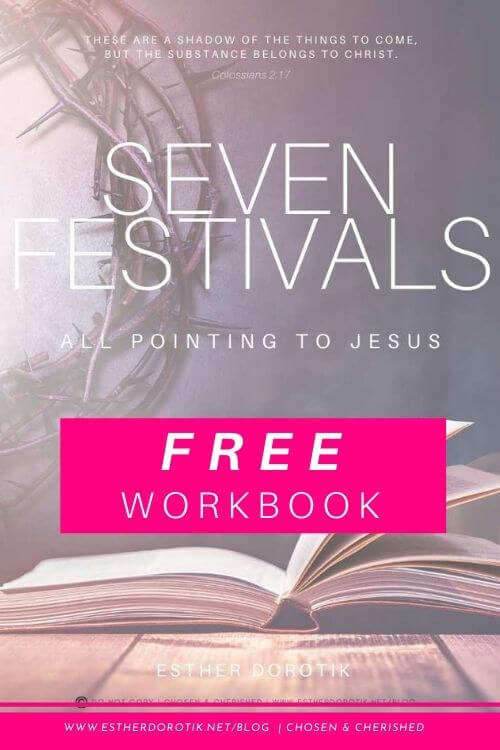
7 | Feast of Tabernacle (Feast of Booths; Festival of Shelters; Feast of Ingathering; Sukkot) – חַג הַסֻּכּוֹת
This was a joyous festival to remember the time of wandering in the wilderness when God dwelt among them. During this festival, they leave the comfort of their home and temporarily live in booths or tents made of thick trees and palm trees. (Referenced in Exodus 34:22; Leviticus 23:33–43; Numbers 29:12–39; Deuteronomy 16:13-17)
- Began on the 15th day of Tishri (5 days after the Day of Atonement). Leviticus 23:34
- The first day was a sabbath day of rest in which no occupational work was done. Leviticus 23:34
- Lasted 7 days, ending on 22nd with another Sabbath day of rest. Leviticus 23:35
- On the 8th day, you shall observe a holy convocation sabbath, a solemn assembly with no ordinary work. Leviticus 23:35
- They were to dwell in booths or tabernacles for 7 days. Leviticus 23:42
- Remember the wanderings of their fathers in the wilderness when God dwelt among them.
- From the beginning of time, God’s desire was for mankind to dwell with Him. He walked with man in the Garden (Genesis 3:8). He led the Israelites through the wilderness by His presence. Through Ezekiel, God foretold of a time when He would dwell among His people forever (Ezekiel 37:26-27). Jesus became flesh and dwelt among us (John 1:14). But the ultimate fulfillment of this feast is when God once again makes His home with His people at the end (Revelation 21:3).
Wow! What a beautiful way God wove the pages of Scripture together into one story – all pointing to Jesus Christ and the redemption of people. My desire for this study is that your hearts will burn with a desire to find Jesus in every one of the 66 books of the Bible. I pray it gives you an understanding of the importance of biblical festivals for Christians.
Be sure to follow along on Pinterest!
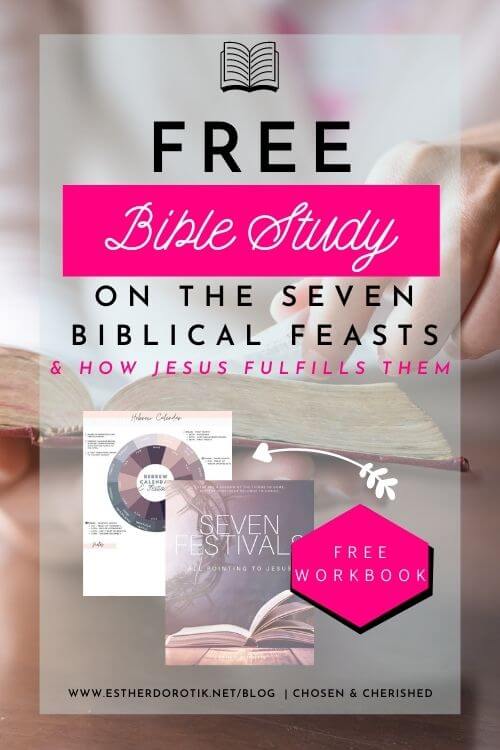
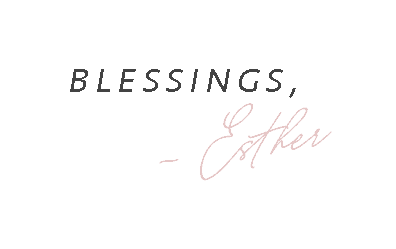

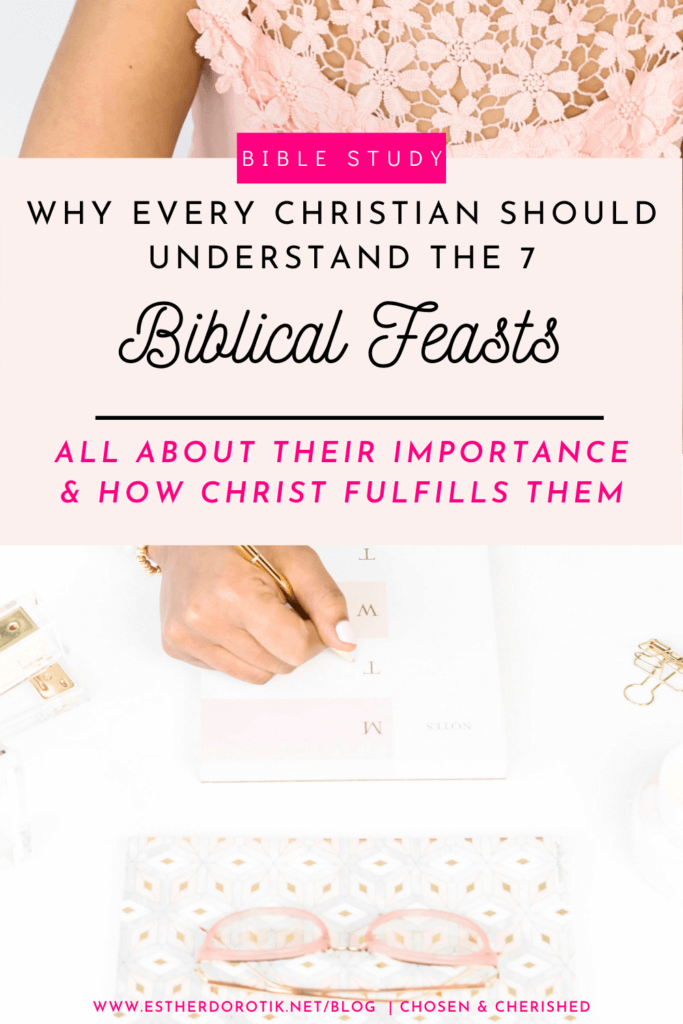
I’ve never understood why God required these, but this makes so much sense! It connects the missing line between the old and new! ❤️
Would it be possible to make the chart available as a free printable? Thank you for diving in and studying this out!
Thank you for such an enlightening commentary. I found it very useful, and we’ll written. Thank you for bestowing your biblical knowledge on us Esther. God bless sweet lady!
This is incredible, and makes it so evident that only God could write the Word!
I agree with Karissa, is it possible to get the chart (& study) in a PDF?
Thank you very much Esther for this valuable study ; We are going to use this for our Sunday school children (10th graders)
I want to learn the and understand the 7 Biblical festivals of the Lord.
Regards,
Peter Pourino